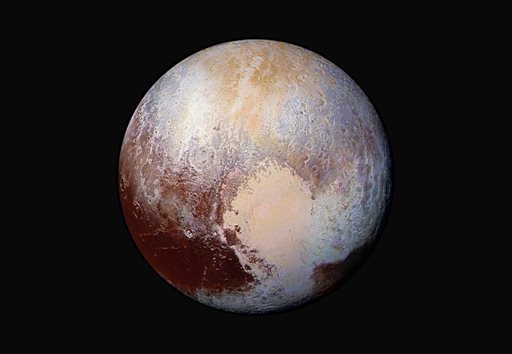Conditions on Pluto: Incredibly hazy with flowing ice

This image made available by NASA on Friday, July 24, 2015 shows a combination of images captured by the New Horizons spacecraft with enhanced colors to show differences in the composition and texture of Pluto’s surface. The images were taken when the spacecraft was 280,000 miles (450,000 kilometers) away. (NASA/JHUAPL/SwRI via AP)
CAPE CANAVERAL, Florida, United States— Pluto is hazier than scientists expected and appears to be covered with flowing ice.
The team responsible for the New Horizons flyby of Pluto last week released new pictures Friday of the previously unexplored world on the edge of the solar system.
READ: Pluto flyby a success; Spacecraft survives 4.8B-km trip — Nasa
“If you’re seeing a cardiologist, you may want to leave the room,” principal scientist Alan Stern teased at the opening of the news conference at Nasa headquarters. “There are some pretty mind-blowing discoveries.”
Nasa’s New Horizons spacecraft, now 7.5 million miles beyond Pluto, has detected layers of haze stretching 100 miles (160 kilometers) into the atmosphere, much higher than anticipated. All this haze is believed to account for the dwarf planet’s reddish color.
If you were standing on Pluto and looking up, you probably wouldn’t notice the haze, said George Mason University’s Michael Summers. In fact, New Horizons had to wait until after its closest approach on July 14, so the sun would silhouette Pluto and the atmosphere could be measured by means of the scattered sunlight.
As for the ice flows, they appear to be relatively recent: no more than a few tens of millions of years, according to William McKinnon of Washington University in St. Louis. That compares with the 4.5 billion-year age of Pluto and the rest of the solar system.
To see evidence of such recent activity, he said, is “simply a dream come true.”
Temperatures on Pluto are minus 380 degrees Fahrenheit (minus 229 degrees Celsius), and so water ice would not move anywhere in such extreme cold. But McKinnon said the nitrogen and other ices believed to be on Pluto would be geologically soft and therefore able to flow like glaciers on Earth.
READ: Pluto Facts: Tiny, icy world gets major attention
Some of that plutonian ice seems to have emptied into impact craters, creating ponds of frozen nitrogen. One of those semi-filled craters is about the size of metropolitan Washington D.C., McKinnon said.
These latest findings support the theory that an underground ocean might exist deep beneath Pluto’s icy crust, McKinnon said.
These ice flows — which might still be active — are found on Pluto’s vast icy plain, now called Sputnik Planum after Earth’s first man-made satellite. The plain is about the size of Texas and occupies the left side of Pluto’s bright heart-shaped feature, named Tombaugh Regio after the late astronomer who discovered Pluto in 1930, Clyde Tombaugh.
It’s evident now that the two “lobes” of the heart are quite different; Stern speculated that nitrogen snow could possibly be blowing from the brighter left, or western, side to the right.
One of Pluto’s newly discovered mountain ranges now bears the name of Sir Edmund Hillary, who along with Sherpa guide Tenzing Norgay conquered Mount Everest in 1953. The New Horizons team already had named another series of mountains after Norgay.
The spacecraft traveled 3 billion miles over 9½ years to get the first close-up look of Pluto. The New Horizons team stressed that most of the collected data are still aboard the spacecraft and will take more than a year to obtain. Over the next several weeks, much of the incoming transmissions will consist of engineering or other technical data — and only a few images.
But starting in mid-September, “the spigot opens again,” promised Stern, a scientist at the Southwest Research Institute. From then until fall 2016, “The sky will be raining presents with data from the Pluto system. It’s going to be quite a ride.”